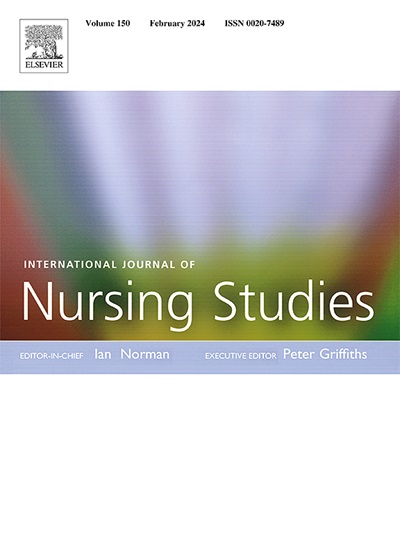血液透析护理个性化症状管理中症状负担的脆弱性和核心干预目标:一项计算模拟建模研究
IF 7.1
1区 医学
Q1 NURSING
引用次数: 0
摘要
背景:终末期肾脏疾病(ESKD)患者接受血液透析(HD)的症状负担很高。尽管症状管理具有重要的临床意义,但由于对症状相互作用的考虑有限,传统方法无法预测干预效果或确定最佳靶点。需要使用症状网络分析的计算模拟来确定个性化护理的核心干预目标。设计采用横断面观测数据的计算模拟建模研究。横跨中国五大区域——北、南、西、东、中。共有1866名血液透析患者参与了这项研究。方法采用以变量为中心和以人为中心相结合的方法,简化患者真实报告数据测量的症状,然后进行潜在特征分析,将患者分类为症状负担谱。使用NodeIdentifyR算法进行计算机干预,以模拟缓解和加重干预对症状网络的影响。结果鉴定出尿毒症毒素、水电解质、心理和胃肠道4个症状群。潜在性分析揭示了两种不同的患者特征:重度和轻度症状组。网络分析突出了瘙痒、疲劳、焦虑和易觉醒等关键症状作为中心节点。各组的计算机干预结果显示,以易醒、疲劳和瘙痒为核心目标的缓解性干预。治疗可使症状负担分别减轻10.25%、10.00%和9.82%。加重干预确定瘙痒,皮肤干燥和易觉醒为关键目标。预防这些疾病的出现可分别减少24.69%、23.05%和22.21%的症状负担。结论本研究对血液透析患者的症状负担提供了重要的见解,为护士个性化护理计划提供了潜在的目标。计算模拟的结果,如果通过进一步的纵向研究进行验证,本研究有可能推动更有针对性和更有效的症状管理护理方法的发展,从而提高患者的护理和生活质量。本文章由计算机程序翻译,如有差异,请以英文原文为准。
Vulnerability and core intervention targets in the symptom burden for personalized symptom management in hemodialysis care: A computational simulation modeling study
Background
End-stage kidney disease (ESKD) patients on hemodialysis (HD) endure a high symptom burden. Despite the clinical importance of symptom management, traditional methods fail to predict intervention effects or identify optimal targets due to limited consideration of symptom interactions. Computational simulations with symptom network analysis to identify core intervention targets for personalized care is needed.
Design
Computational simulated modeling study using cross-sectional observational data.
Setting
Across five regions of China—northern, southern, western, eastern, and central.
Participants
A total of 1866 hemodialysis patients participated in the study.
Methods
A combination of variable-centered and person-centered approaches was used to simplify the symptoms measured by real patient-reported data, followed by latent profile analysis to classify patients into symptom burden profiles. In silico interventions were performed using the NodeIdentifyR algorithm to simulate the effects of alleviating and aggravating interventions on the symptom network.
Results
Four symptom clusters were identified: uremic toxin, water-electrolyte, psychological, and gastrointestinal. Latent profile analysis revealed two distinct patient profiles: severe and mild symptom groups. Network analysis highlighted key symptoms such as pruritus, fatigue, anxiety, and easy awakening as central nodes. The in silico interventions in overall groups showed that alleviating interventions targeting easy awakening, fatigue and pruritus as core targets. Treating these may reduce the symptom burden by 10.25 %, 10.00 % and 9.82 %. Aggravating interventions identified pruritus, dry skin and easy awakening as pivotal targets. Preventing the presence of these may separately reduce the symptom burden by 24.69 %, 23.05 % and 22.21 %.
Conclusion
This study provides critical insights into the symptom burden of hemodialysis patients, offering potential targets for personalized care plans for nurses. The results of computational simulations, if go through further longitudinal study for verification, the study has potential to advance the development of more tailored and effective symptom management care approaches, which could enhance patient care and quality of life.
求助全文
通过发布文献求助,成功后即可免费获取论文全文。
去求助
来源期刊
CiteScore
15.00
自引率
2.50%
发文量
181
审稿时长
21 days
期刊介绍:
The International Journal of Nursing Studies (IJNS) is a highly respected journal that has been publishing original peer-reviewed articles since 1963. It provides a forum for original research and scholarship about health care delivery, organisation, management, workforce, policy, and research methods relevant to nursing, midwifery, and other health related professions. The journal aims to support evidence informed policy and practice by publishing research, systematic and other scholarly reviews, critical discussion, and commentary of the highest standard. The IJNS is indexed in major databases including PubMed, Medline, Thomson Reuters - Science Citation Index, Scopus, Thomson Reuters - Social Science Citation Index, CINAHL, and the BNI (British Nursing Index).

 求助内容:
求助内容: 应助结果提醒方式:
应助结果提醒方式:


